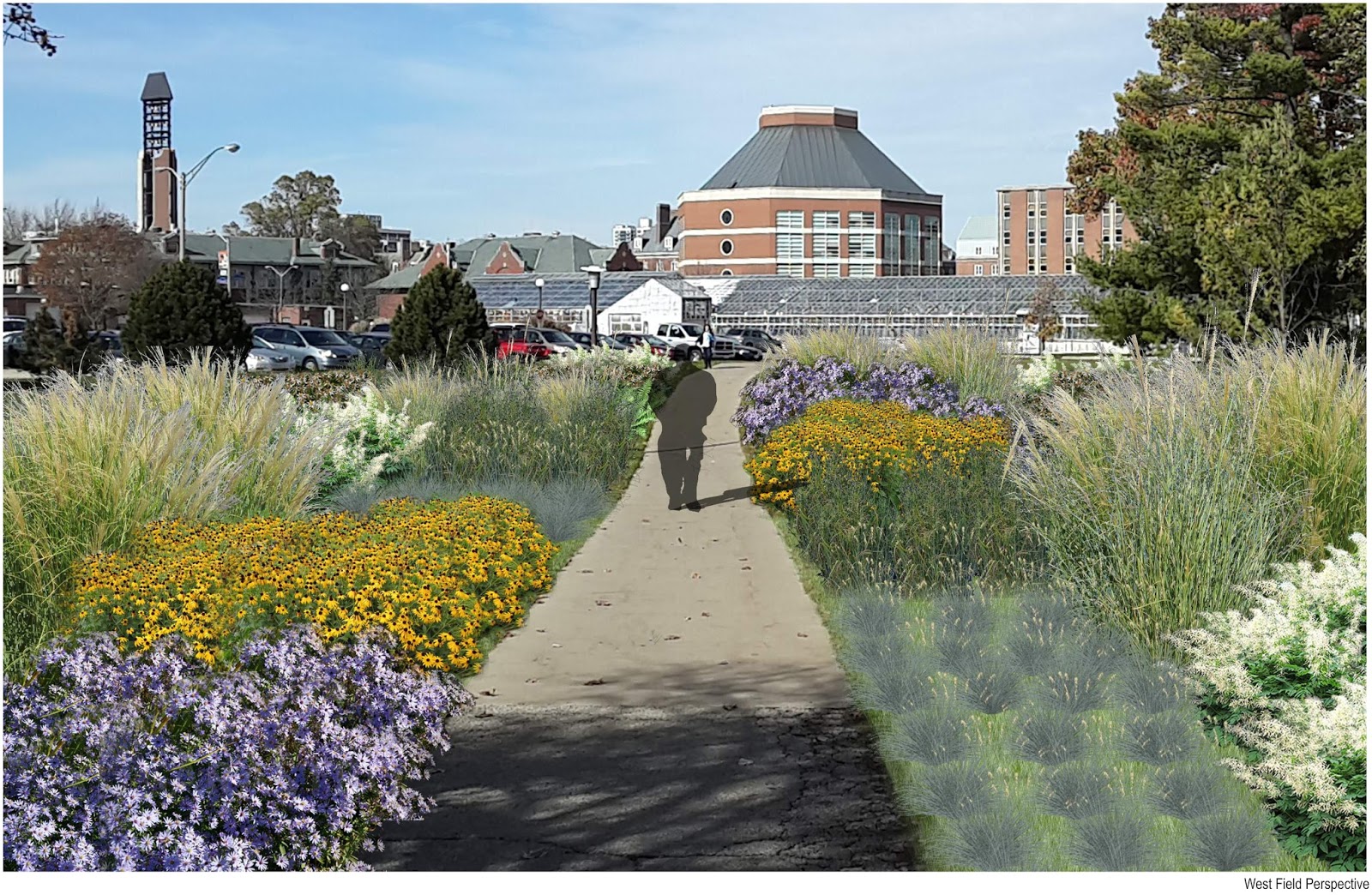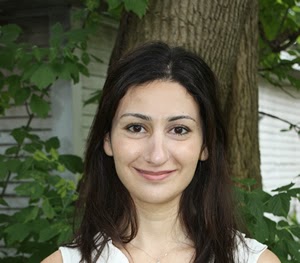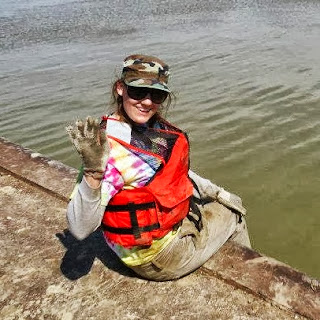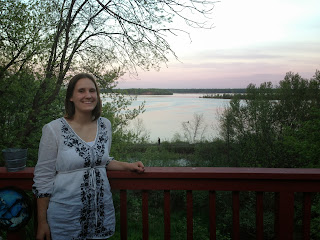November 20th, 2014 by iisg_superadmin
Eliana Brown recently joined the Illinois Water Resources Center as an outreach specialist. Prior to starting at IWRC, she worked at University of Illinois at Urbana-Champaign Facilities & Services as the MS4 coordinator and at Illinois EPA as a field engineer. Eliana has a M.S. in environmental engineering and a B.S. in general engineering and marketing from the University of Illinois.
The following is a contributing post from Eliana, who has a passion for rain gardens and green infrastructure:
When you were a university student, did you ever reimagine your campus landscape? Students at the University of Illinois did exactly that as an assignment for Landscape Architecture (LA) 452, Native Plants and Design.
The U of I campus has 84 miles of storm sewer, most of which drain rainwater directly to Boneyard Creek. The LA 452 students designed landscapes with elements that capture water and allow it to soak in on-site to reduce loads to the existing storm sewer and creek. These elements (called green infrastructure) include rain gardens, swales, and green roofs. The Environmental Protection Agency (EPA) sees green infrastructure as a way to create sustainable, resilient communities that improve water quality.
EPA has a competition called the Campus RainWorks Challenge that invites “student teams to design an innovative green infrastructure project for their campus showing how managing stormwater at its source can benefit the campus community and the environment.”
According to Jason Berner, EPA environmental protection specialist, who has been involved with administering the competition, it is a great way for students to see how green infrastructure is related to the larger campus master plan. “It moves us beyond single pilot projects, but at the same time, blends both small and large scale thinking,” he explained.
LA 452 instructor Tawab Hlimi is leading the U of I Campus RainWorks entry. Students in his class helped brainstorm ideas for the entry. One of those ideas is pictured. Student Jiwon
Kim reimagined the grounds at the National Soybean Research Building (which happens to house Illinois-Indiana Sea Grant and the Illinois Water Resources Center). Native plant rain gardens intercept stormwater from the building roof and parking lot. During large storms, the design takes advantage of existing storm sewers by overflowing excess water to them.
Like many cities and universities, the U of I began installing storm sewers more than 100 years ago. Storm sewers benefit cities by draining flooded areas. However, they can overload receiving streams and cause unintended damage. Adding green infrastructure elements to the existing infrastructure helps ensure a healthier ecosystem on-site and downstream.
Per Hlimi, “Through a campus wide application of rain gardens, students hybridized native plantings with a superficial stormwater management strategy to meet multiple objectives: accommodating the ‘first flush’ of frequent storm events through detention, infiltration, and biofiltration, reducing the load on existing subsurface infrastructure, improving the water quality entering into the Boneyard Creek, creating habitat for pollinators, and rendering the campus landscape as living laboratory.”
Perhaps one day in the not too distant future, students won’t have to imagine green infrastructure on campus. They’ll see it.
May 1st, 2014 by iisg_superadmin
 Residents and visitors alike can learn more about the beloved Chicago lakefront with our new Chicago Water Walk mobile tour. The app offers a self-guided walking tour of the city’s historic and scenic shoreline from Navy Pier to the Museum Campus, with stops and landmarks along the way.
Residents and visitors alike can learn more about the beloved Chicago lakefront with our new Chicago Water Walk mobile tour. The app offers a self-guided walking tour of the city’s historic and scenic shoreline from Navy Pier to the Museum Campus, with stops and landmarks along the way.
Chicago Water Walk takes users on a journey through time to discover how Lake Michigan and the Chicago River transformed a small trading post into one of the economic and cultural hubs of the world—and the vital role these natural resources play in the city’s present and future.
The app explores some of the city’s most celebrated sites—Navy Pier, the Chicago River, downtown marinas, Buckingham Fountain, and Museum Campus. Each stop combines history, current events, and water sciences with fun facts to show the importance of aquatic ecosystems in the city’s past, present, and future. Stunning photos, historical images, and links to videos and other resources bring these issues to life and reveal a lakefront that will surprise even lifelong Chicagoans.
Through the tour you’ll learn why the decision to reverse the Chicago River is still making waves more than a century later, how a city that sits along Lake Michigan can be concerned about having enough water in the future, and how native trees and plants are helping the city prepare for changing weather patterns. You’ll also find out about efforts to restore much-needed habitats for millions of birds, fish, and other wildlife.
With 18 stops across four routes, Chicago Water Walk is easily customized to enhance any trip to the lakefront. You can follow the suggested leg or visit the sites that most appeal to you using the interactive map.
You can download Chicago Water Walk for free on both Android and Apple devices. It was developed by Illinois-Indiana Sea Grant, with funding from the Illinois Department of Natural Resources and technical support from the University of Illinois Administrative Information Technology Services.
March 20th, 2014 by iisg_superadmin
A group of urban planning graduate students from University of Illinois have just returned from Milwaukee—but this wasn’t your typical weekend excursion. They spent their time interviewing government employees, business owners, members of the community, and others affected by clean-up efforts on the Milwaukee Estuary, where industrial toxins threaten water quality and aquatic wildlife. And the information they collected will go a long way to ensuring that future restoration and remediation projects across the region leave nearby communities stronger than they were before.
 It is all a part of an IISG-funded project investigating the relationship between sediment removal projects and a community’s vulnerability to environmental hazards like natural disasters, pollution, and changing weather patterns. Social vulnerability depends on a lot of factors—average income, education levels, public engagement, and more. Using the Milwaukee Estuary and Grand Calumet Areas of Concern as models, U of I researchers Bethany Cutts and Andrew Greenlee are investigating how these factors change—for better or worse—when a community becomes involved in sediment removal projects.
It is all a part of an IISG-funded project investigating the relationship between sediment removal projects and a community’s vulnerability to environmental hazards like natural disasters, pollution, and changing weather patterns. Social vulnerability depends on a lot of factors—average income, education levels, public engagement, and more. Using the Milwaukee Estuary and Grand Calumet Areas of Concern as models, U of I researchers Bethany Cutts and Andrew Greenlee are investigating how these factors change—for better or worse—when a community becomes involved in sediment removal projects.
This project stands apart from much of the research on community vulnerability. It is localized, focused on vulnerability over time, and supplements census data with qualitative information on community attitudes and perceptions of remediation. Because of these differences, its results will be a significant boost to the tool government agencies currently use to determine and reduce social vulnerability, the Social Vulnerability Index. Cutts and Greenlee are calling their tool the Social Vulnerability Index Plus (SoVI+).
When it is done, SoVI+ will help groups involved in remediation, including IISG, better prepare communities for the aspects of cleanup that may increase vulnerability—like restricted road access and heavy truck traffic. EPA could also use the new tool to prioritize sediment remediation in areas where it will be most beneficial.
 Work is just beginning, but the project promises a lot of data collection and analysis over the next few years. That is where the students come in. They are all part of the Workshop in Urban Environmental Equity, an inter-departmental course focused on identifying historical demographic changes in the researched regions, as well as developing and piloting interview strategies that Cutts and Greenlee will continue to use well after the course is complete. Beyond being a big step forward for the research project, the workshop provides a unique opportunity for students to be a part of the design and implementation of a multidisciplinary, mixed-method research project—what one student called “the holy grail” of research. Situated at the intersection of social and economic shifts, environmental restoration, planning, and policy, the course and the research can have tremendous benefits for ongoing and future remediation projects and the coastal communities.
Work is just beginning, but the project promises a lot of data collection and analysis over the next few years. That is where the students come in. They are all part of the Workshop in Urban Environmental Equity, an inter-departmental course focused on identifying historical demographic changes in the researched regions, as well as developing and piloting interview strategies that Cutts and Greenlee will continue to use well after the course is complete. Beyond being a big step forward for the research project, the workshop provides a unique opportunity for students to be a part of the design and implementation of a multidisciplinary, mixed-method research project—what one student called “the holy grail” of research. Situated at the intersection of social and economic shifts, environmental restoration, planning, and policy, the course and the research can have tremendous benefits for ongoing and future remediation projects and the coastal communities.
Photo A: Natalie Prochaska, Juliana Wilhoit, Andrew Greenlee, Annie Contractor, Vinisha Doshi, Nancy Smebak, and Rachel Wilson take a break from their work in Milwaukee. (Not pictured: urban planning graduate student and workshop member Carolina Chantrille.)
Photo B: U of I students take part in a “Ski the AOC” event to learn more about ongoing remediation efforts and the community.
March 7th, 2014 by iisg_superadmin
Najwa Obeid’s experiences as a Knauss Fellow at the National Science Foundation can perhaps most accurately be described as diverse. And that diversity, she said, will go a long way in helping her achieve her goal of working on water and coastal policy.
Her greatest exposure to policy came while participating in an ecosystem-based management working group with representatives from agencies like the Department of the Interior, NOAA, the U.S. Navy and EPA. Ecosystem-based management is a type of resource management that focuses on whole ecosystems instead of individual species or resources and is one of nine policy recommendations included in the National Ocean Policy Implementation Plan. The group – officially known as the National Ocean Council ecosystem-based management interagency subgroup – was charged with determining what this recommendation meant for each agency and identifying work priorities and pilot projects. In her role with the National Science Foundation, Najwa identified science and knowledge gaps and connected the group with academic experts.
“I have a better idea now of how things do and should work, particularly when there are a lot of agencies involved,” said Najwa, a Ph.D. candidate at University of Illinois Urbana-Champaign. “Reading about the work is one thing, but being immersed in it adds much more value.”
And, like her co-fellow Will Tyburczy, Najwa has some advice for those considering a Knauss fellowship.
“If you have any sort of interest in policy or want to be involved with work that has a faster and more direct social impact,” she advised, “give it a try. It is a very unique and educational year.”
For more information about the Sea Grant Knauss fellowship and other fellowship opportunities, please visit the IISG
Fellowship and Scholarship page.
February 26th, 2014 by iisg_superadmin
One of the best online resources for sustainable landscape and lawn care in Illinois is now available in Spanish. Like its sister site Lawn Talk, Hablemos Del Cesdped includes tips and resources for planting and maintenance, including common lawn care mistakes to avoid.
With help from these sites, homeowners and landscape professionals in northern Illinois can cultivate healthy lawns while still conserving water and preventing harmful chemicals from washing into nearby lakes and rivers. Specific natural lawn care tips include testing soil and adjusting nutrient levels as needed at the start of the season, choosing the right grass for the site, and letting lawns go dormant during dry months. The sites also provide information on lawn cultivation equipment and choosing lawn care services.
February 11th, 2014 by iisg_superadmin
Illinois river otters are just one of the susceptible organisms in the local environment, and a recent study is showing that they are indicating some very high levels of dangerous toxins (including a banned insecticide).
“‘Thus otters serve as biomonitors – organisms that contain information on the quantitative and qualitative aspects of the environment – of wildlife exposure,’ according to a new study. They also serve as biomonitors for human health because the same toxic chemicals found in otters have also been found in people who eat contaminated fish.
The study published in the journal ‘Ecotoxicology and Environmental Safety’ found high concentrations of chemical compounds in the livers of 23 otters in central Illinois.
Especially troubling were the highest concentrations of dieldrin ever reported in otters anywhere in the United States, said lead author Samantha Carpenter, a wildlife technical assistant at the University of Illinois, Urbana-Champaign.
Dieldrin is one of the organochlorine insecticides banned in 1978. More than three decades later, high levels of the chemicals remain in river sediments and accumulate in the fish that otters and people may eat.
The compound has been linked to neurological, behavioral and immune-suppression problems in wildlife. Scientific studies disagree on adverse human effects, but some studies have linked dieldrin to asthma, Parkinson’s disease, Alzheimer’s disease and breast cancer, Carpenter said.”
Read the complete article at the link above.
January 22nd, 2014 by IISG
The cure for some of the world’s deadliest diseases may be living at the bottom of the Great Lakes. This is the theory Brian Murphy, a medicinal chemist at the University of Illinois at Chicago (UIC), set out to test in 2012 when he scoured Lake Huron in search of a largely unexplored type of bacteria that may hold the key to new treatments.
The IISG-funded study unearthed more than 600 strains of freshwater actinomycete bacteria, making it one of the largest “libraries” of its kind in the world. Murphy—with help from UIC researchers Scott Franzblau, Joanna Burdette, and Lijun Rong—is still testing whether these strains can be used to create new treatments for tuberculosis and other life-threatening diseases. But their initial results suggest that at least a handful of freshwater bacteria could lead to new cures.
A microbe’s medicinal power lies in the small compounds they make to defend themselves, which can destroy cell walls, prevent DNA from replicating like it should, and more. Current treatments for many diseases are built around the chemical defenses used by land-based cousins of the bacteria Murphy has collected. But some treatments, like the ones for tuberculosis, require patients to be on a complex cocktail of antibiotics for months at a time. Worse still, a growing number of diseases are now resistant to standard drugs. The hope is that some of the freshwater bacteria in Murphy’s library might create molecules that dangerous pathogens have yet to evolve defenses against.
“Researchers have been operating on the assumption that bacteria in the lake are nearly identical to what are found on the land,” said Murphy. “But we think these freshwater strains are likely to produce new molecules that target diseases in different ways.”
Murphy and his team will spend the next few months scrutinizing chemical compounds from 10 actinomycete strains already showing disease-fighting potential and comparing them against known antibiotics, anti-virals, and anti-cancer agents. At the same time, they will keep working through their bacterial library hoping to find even more molecules with drug-like potency.
Just as important as finding new molecules is learning more about the relationship between a microbe’s chemical properties and where it lives. This is where Murphy’s library of strains really comes in. Its size and diversity will help reveal both whether aquatic actinomycete bacteria are significantly different than their land-based counterparts and if strains found in different lakes use unique chemical defenses.
“One of the biggest barriers in the discovery of new drugs is knowing where to look,” said Murphy. “Knowing where bacteria populations are similar and where they are different helps us figure out exactly where to sample when looking for new drugs.”
Because of his collection, Murphy has already discovered that the makeup of actinomycete communities in Lake Huron varies both by location and depth, a diversity that makes the lake a potentially important site in the hunt for new cures.
October 18th, 2013 by Irene Miles
Emily Anderson graduated from Northern Illinois University this past spring and was able to put her studies to work right away as one of our summer interns. She wrote in to tell us about her experience working with Caitie McCoy on outreach and social science efforts related to sediment remediation.
“This summer I interned with Illinois-Indiana Sea Grant as the Human Dimensions of Natural Resources Intern. When I found the listing for the IISG Internship position I knew right away it was right for me. I was ecstatic to find a position that aligned with my interests in both psychology and environmental science, so I excitedly submitted my application and then waited nervously. Days after I walked across the stage as a 2013 graduate from Northern Illinois University, I relocated from DeKalb, Illinois to my new office on the University of Illinois’ campus.
Throughout the summer I traveled around the Great Lakes with my mentor Caitie McCoy and collected data on people’s perceptions of contaminated sediments. One of Sea Grant’s missions is to conduct research across the Great Lakes; as such, my job was to assist Caitie in conducting a study on two contaminated rivers slated for cleanup. In order to restore the health of the Great Lakes ecosystem and restore benefits to the local communities, the GLLA funds sediment remediation and habitat restoration in connecting waterways. The purpose of our research was to gain an understanding of how people in these communities relate to their river so that this information could be used to guide outreach efforts at these and other contaminated sites. We were also interested in the different benefits that communities receive from these waterways and how cleanup efforts might enhance those resources. In order to get a site-specific understanding we traveled to different locations and interviewed local leaders.
After learning about the background and purpose of the GLLA program, my first task was to recruit interview participants. I am rather shy normally, but conducting the recruitment communications and helping with the interviews was a great experience to break me out of my shell. I was pretty nervous during my first recruitment call, but after speaking with an extremely nice and generous person who invited us to go fishing during our interview I became much more comfortable. With help from our local outreach teams, we ended up with nearly 45 interviewees between our two sites (Duluth, MN and Sheboygan, WI).
I really love to travel, see new places, and learn new things so I have to say conducting the interviews was my favorite part of the internship. Both cities were beautiful in their unique way, and I’d definitely visit again if I got the chance. (In fact I’d consider living in Duluth despite an average of 80 inches of snowfall per year.) It was so interesting to get to listen to people’s stories and learn about the environmental issues in the Midwest. After the site visit I got right to work at transcribing the interviews which I will admit was not my favorite part of the experience but was a very valuable task and an opportunity to develop a new skill.
Before this internship most of the research I had been involved in was quantitative so the idea of data analysis guided by intuition was sort of foreign to me. At first I stumbled through the process but I found conceptual ground and eventually was able to enjoy qualitative analysis. Because of my concern for the health of the environment and my interest in social science it really gives me a great feeling to know that research like this is being conducted. In the end I feel accomplished; the study I helped with this summer will guide future outreach at the sites we visited and add to our understanding of the benefits of river cleanups. And ultimately that will help prove the real-world value and impact of programs like GLLA. This internship reaffirmed my passion for research and exposed me to a multitude of career options that are directly in line with my interests. I leave this position with a little more direction and a lot more hope for the future of the Great Lakes.”
Emily is one of four interns who worked with IISG this summer. You can read about Alice’s experience here, John’s here, and look forward to another post soon.
September 16th, 2013 by Irene Miles
Recent research indicates that even a handful of Asian carp, between just ten and twenty fish, could establish an ecologically damaging population in the Great Lakes.
From ScienceDaily.com:
“Published this week in the Biological Invasions journal, research from Professor Kim Cuddington of the Faculty of Science at Waterloo indicates that the probability of Asian carp establishment soars with the introduction of 20 fish into the Great Lakes, under some conditions…
‘This species will have a huge impact on the food web,’ says Professor Cuddington. ‘Not only is it a fast-growing fish physically, but the population itself grows very quickly. A female can lay well over a million eggs a year, and with no known predators present in the Great Lakes, the Asian carp could dominate the waters and impact fisheries.’…
Individual fish have already been caught in two of the Great Lakes. The probability of Asian carp establishment changes dramatically if only 10 of the creatures are introduced. With 10 fish, the probability of a population of Asian carp is only 50 per cent, but with 20 fish, it jumps to 75 per cent, under some conditions.”











